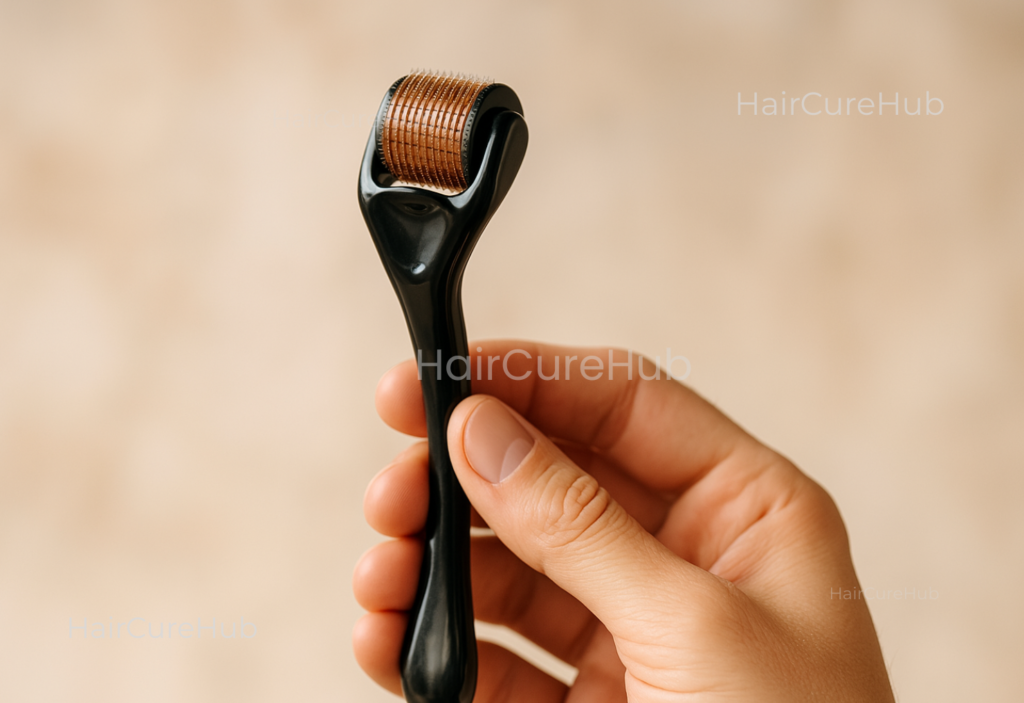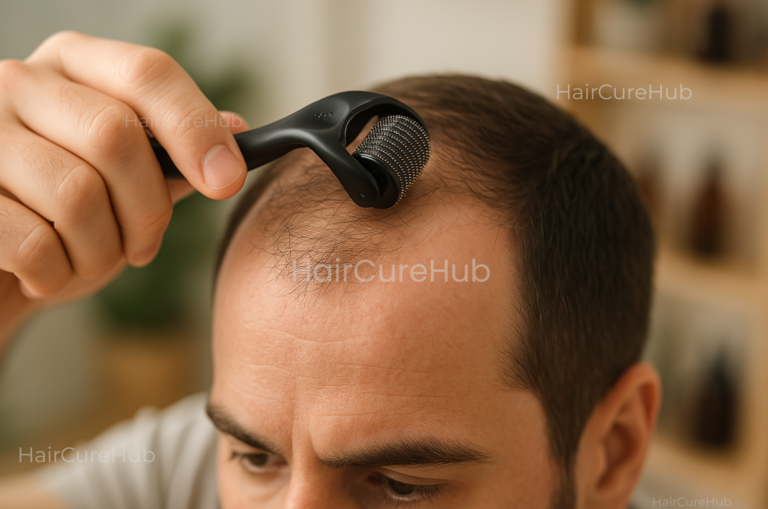DermaRolling | MicroneedlingForHair | HairGrowthSecrets | HairThinningSolutions | ScalpHealth | HairRegrowthTreatment | HairCareGuide | NaturalHairSolutions
Unlock the Science of Microneedling for Thicker, Healthier Hair
Hair loss and thinning hair affect millions worldwide, leading many to seek non-invasive solutions that actually deliver results. One treatment gaining popularity in hair regrowth is the derma roller, a simple yet powerful tool that has been used in skincare for years and is now making waves in the hair restoration world.
But does microneedling with a derma roller really work for stimulating hair follicles and promoting growth? Could this be the affordable alternative to expensive hair loss treatments?
A derma roller is a handheld device covered in tiny microneedles that create micro-injuries in the scalp. This process triggers the body’s natural healing response, increasing blood circulation, collagen production, and nutrient absorption, which may stimulate dormant hair follicles and lead to new hair growth.
Why Is the Derma Roller a Game-Changer for Hair Growth?
The derma roller is a handheld device equipped with hundreds of tiny needles that are gently rolled over the scalp to create micro-injuries. This controlled damage triggers the body’s natural healing mechanisms, producing growth factors and proteins crucial for hair follicle regeneration.
Here’s why it’s gaining so much attention:
- Boosts Blood Flow to Hair Follicles – The micro-injuries enhance circulation, bringing more oxygen and nutrients to undernourished hair roots.
- Activates Collagen Production – Stimulates collagen and elastin, which strengthen hair anchoring and improve scalp elasticity.
- Enhances Absorption of Topical Treatments – Increases the penetration of minoxidil, peptides, rosemary oil, and other growth serums.
This trifecta of benefits makes the derma roller an essential addition to any hair regrowth regimen.
The Science Behind Microneedling for Hair Regrowth
Microneedling is not just cosmetic hype—it’s a scientifically validated treatment. The mechanism works through wound-healing pathways, which involve:
- Activation of stem cells in the bulge area of hair follicles
- Stimulation of angiogenesis (new blood vessel formation)
- Release of growth factors such as platelet-derived growth factor (PDGF), epidermal growth factor (EGF), and vascular endothelial growth factor (VEGF)
These biologic processes jumpstart dormant hair follicles, improve follicular health, and increase the time spent in the anagen (growth) phase of the hair cycle.
Clinical Studies on Derma Rolling for Hair Regrowth
Multiple peer-reviewed studies support microneedling as an effective tool for hair regeneration:
- A 2013 study published in the International Journal of Trichology found that patients who used a derma roller alongside 5% minoxidil showed four times more hair regrowth than those using minoxidil alone.
- Another 2021 clinical trial observed that bi-weekly microneedling significantly improved hair density and scalp condition within 12 weeks, especially when paired with a topical growth serum.
These findings show that the derma roller isn’t a passing trend—it’s a serious contender in modern hair therapy.
Key Benefits of Using a Derma Roller for Hair
✔ Stimulates Dormant Hair Follicles – Encourages new growth in areas affected by miniaturization and recession.
✔ Strengthens Hair from the Root – Collagen and elastin improve follicle integrity and prevent early shedding.
✔ Reduces Hair Shedding – Supports hair retention by improving blood flow and nutrient delivery to weakened follicles.
✔ Improves Absorption of Hair Growth Products – Enhances penetration and effectiveness of topical treatments.
✔ Affordable & Non-Invasive – An at-home, cost-effective option compared to PRP therapy or surgical transplants.
How to Use a Derma Roller for Hair Growth

Using a derma roller requires consistency and care. Here’s a detailed guide to doing it safely and effectively:
1. Choose the Right Needle Size
- 0.25mm to 0.5mm: Best for improving serum absorption and scalp stimulation.
- 1.0mm: Effective for encouraging hair regrowth in mild to moderate thinning.
- 1.5mm: Suitable for deeper scalp penetration and more advanced cases—but should be used less frequently and with professional guidance.
2. Step-by-Step Application
Step 1: Disinfect the Roller
Soak your derma roller in 70% isopropyl alcohol for 5–10 minutes before every session.
Step 2: Cleanse Your Scalp
Wash your scalp with a gentle shampoo to remove oil and dirt. Dry thoroughly.
Step 3: Apply Growth Serum (Optional)
Apply a topical like minoxidil, rosemary oil, caffeine solution, or peptides to enhance the results.
Step 4: Roll the Device Gently
Roll the derma roller horizontally, vertically, and diagonally across thinning areas, 5–10 times per direction. Do not apply heavy pressure—gentle passes are enough.
Step 5: Disinfect Again
After use, rinse and disinfect the roller. Store in a clean case.
Frequency of Use
- 0.25–0.5mm needles: 2–3 times per week
- 1.0mm+ needles: Once a week or every 10–14 days
Let your scalp heal between sessions to avoid inflammation.
Enhancing Derma Roller Results with Hair Serums
Microneedling works best when combined with effective serums. Here’s how each one helps:
- Minoxidil (5%): Stimulates the anagen phase and increases follicular activity.
- Peptides (like GHK-Cu): Repair and strengthen scalp tissue while improving hair strand quality.
- Rosemary Oil: A natural DHT blocker shown to rival minoxidil in promoting hair density.
- Caffeine-based Serums: Improve blood flow and energize follicular cells.
Apply these serums either before or after derma rolling depending on their formulation. Water-based serums can usually be applied beforehand, while oils and thick products are better post-rolling.
Potential Side Effects and Precautions
Derma rolling is generally safe when done correctly, but here are a few things to keep in mind:
- Avoid using on active scalp infections, acne, or eczema.
- Do not use dull or dirty rollers—this can cause injury or infection.
- Expect mild redness or sensitivity after sessions—this is normal and usually subsides within a few hours.
- Never share your derma roller with others.
If you’re new to microneedling, start with a 0.25mm needle and gradually increase size as your scalp adapts.
Who Should Consider Derma Rolling for Hair Growth?
This method is ideal for:
✔ Men and women with early to moderate hair thinning
✔ Those experiencing post-COVID hair loss or stress-related shedding
✔ Individuals wanting to boost the effectiveness of hair serums or minoxidil
✔ People looking for a non-surgical, natural way to encourage regrowth
However, it may not be effective for completely bald areas with no active follicles. In such cases, hair transplants or PRP therapy might be better suited.
Final Thoughts: Is a Derma Roller Worth It for Hair Regrowth?
If you’re seeking a safe, affordable, and scientifically validated method to fight hair loss, the derma roller is an excellent option. It works by waking up dormant follicles, improving scalp health, and supercharging your topical hair products.
While results won’t appear overnight, consistent use over 3–6 months has been shown to increase hair thickness, volume, and density.
So, is it worth it? Absolutely—especially if you’re committed to long-term hair health and want a DIY tool that works in harmony with your body’s natural regeneration processes.
Microneedling is like sending a wake-up call to your scalp—activating its power to grow, repair, and thrive naturally
Medical Disclaimer: This article is for informational purposes only and should not replace professional medical advice. Consult with a healthcare provider before starting any new treatment or supplement.
Can Collagen Be the Secret to Stronger, Thicker Hair?Explore the science-backed benefits of collagen supplements, how they support hair follicle health, and their role in preventing hair thinning and breakage.
👉 Click here to unlock the full potential of Collagen Supplements for hair growth and discover how they can transform your hair health naturally.
How we reviewed this article:
SOURCES
HairCureHub follows strict sourcing guidelines and relies on reputable articles, medical journals, and trusted sources. We prioritize accuracy and integrity by using only high-quality, credible references and never promote exaggerated claims or unverified remedies. Our experts continually track advancements in Hair Wellness and Care, ensuring our articles reflect the latest research and trusted information. Learn more about our commitment to reliable content by reading our policy.
Microneedling and Its Use in Hair Loss Disorders
https://pmc.ncbi.nlm.nih.gov/articles/PMC8776974
A Randomized Evaluator Blinded Study of Effect of Microneedling in Androgenetic Alopecia
https://pmc.ncbi.nlm.nih.gov/articles/PMC3746236
Advances in microneedles research based on promoting hair regrowth
https://www.sciencedirect.com/science/article/abs
Dermaroller for hair growth
https://www.medicalnewstoday.com/articles/dermaroller-for-hair


